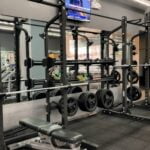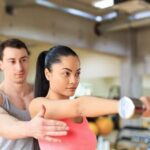Are you looking to enhance your snowboarding performance on the slopes? Incorporating specific exercises for snowboarding fitness into your routine can help you develop the strength, balance, and endurance needed to excel in this exhilarating winter sport. Whether you’re a beginner or a seasoned snowboarder, focusing on fitness training can take your skills to the next level and reduce the risk of injury.
Engaging in exercises for snowboarding fitness not only improves your physical condition but also enhances your overall enjoyment of the sport. From boosting cardiovascular health to increasing muscle strength and flexibility, these workouts play a crucial role in preparing your body for the demands of snowboarding. By dedicating time to targeted fitness routines, you can optimize your performance on the slopes and prolong your time enjoying this adrenaline-fueled activity.
In this article, we will delve into the various aspects of snowboarding fitness, including warm-up routines, strength training exercises, balance and stability drills, cardiovascular conditioning workouts, flexibility exercises, injury prevention tips, and recovery techniques. By understanding how each component contributes to your overall fitness as a snowboarder, you can tailor your workout regimen to suit your individual needs and goals.
So grab your board and get ready to elevate your snowboarding game with these effective exercises designed to enhance your physical abilities on the mountain.
Benefits of Snowboarding Fitness Exercises
Snowboarding is a physically demanding sport that requires a good level of fitness to truly enjoy and excel at. Incorporating specific exercises for snowboarding fitness into your regular workout routine can greatly enhance your overall performance on the slopes. Not only will these exercises help you improve your skills and technique, but they will also provide numerous benefits for your overall health and well-being.
One of the key benefits of incorporating exercises for snowboarding fitness is the improvement in overall strength and endurance. Snowboarding requires strong leg muscles for stability and control, as well as core strength for balance and coordination. By focusing on strength training exercises such as squats, lunges, and deadlifts, you can build up the necessary muscle groups to power through turns and tricks on the mountain.
Another important benefit of snowboarding fitness exercises is the enhancement of balance and stability. Maintaining a stable position while navigating uneven terrain and performing tricks is crucial in snowboarding. Incorporating balance exercises like single-leg squats, stability ball exercises, or yoga poses into your routine can help improve your proprioception and reduce your risk of falls or injuries on the slopes.
Additionally, cardiovascular conditioning plays a significant role in snowboarding fitness. Snowboarding involves bursts of intense activity followed by periods of rest or lower intensity movements.
To prepare for this type of demand on your cardiovascular system, incorporating high-intensity interval training (HIIT), cycling, or jogging into your workout regimen can help increase your stamina and endurance while snowboarding. By focusing on these specific exercises for snowboarding fitness, you can not only improve your performance on the slopes but also enhance your overall fitness level both on and off the mountain.
Warm-Up Routine for Snowboarding
When it comes to snowboarding, having a proper warm-up routine is essential to prepare your body for the physical demands of the sport. A good warm-up can help prevent injuries, improve performance, and enhance overall flexibility. Before hitting the slopes, try incorporating these exercises into your warm-up routine:
- Dynamic stretching: Perform dynamic stretches that mimic the movements you will be doing while snowboarding. This can include leg swings, arm circles, lunges with twists, and hip circles.
- Jumping jacks: Get your heart rate up and increase blood flow to your muscles with a set of jumping jacks. This exercise also helps to warm up your shoulder joints and core muscles.
- Squats: Squats are great for warming up your lower body muscles, including quadriceps, hamstrings, and glutes. Make sure to focus on proper form to prevent any injuries.
In addition to these exercises, consider incorporating some light cardio activities like jogging or jumping rope to further elevate your heart rate and get your body ready for the slopes. It’s important to listen to your body during the warm-up routine and make adjustments as needed based on how you’re feeling that day. By prioritizing a thorough warm-up before snowboarding, you can set yourself up for a successful and safe day on the mountain.
Remember that engaging in specific exercises for snowboarding fitness can not only enhance your performance but also reduce the risk of injury. So, dedicate time before each session to properly warm up those muscles and prime them for action. Your body will thank you for it later as you carve down the runs with strength and agility.
Strength Training Exercises for Snowboarding
Snowboarding requires a great deal of strength in various muscle groups to perform well on the slopes. Incorporating specific strength training exercises into your workout routine can help improve your snowboarding performance and reduce the risk of injuries. One key area to focus on is building lower body strength, particularly in the quads, hamstrings, and glutes. Squats, lunges, and deadlifts are excellent exercises to target these muscle groups and enhance your snowboarding abilities.
In addition to lower body strength, it’s important to also work on your core strength as it plays a crucial role in maintaining balance and stability while snowboarding. Core exercises such as planks, Russian twists, and mountain climbers can help strengthen your abdominal muscles and improve overall body control on the board. A strong core not only enhances your snowboarding skills but also reduces the strain on your back during long hours on the slopes.
To ensure a well-rounded strength training regimen for snowboarding fitness, incorporating upper body exercises is beneficial as well. Building arm and shoulder strength through exercises like push-ups, shoulder presses, and rows can help you maintain control of your movements and make quick adjustments while snowboarding.
By strengthening both upper and lower body muscle groups along with core stability, you can enhance your overall performance on the slopes and have a more enjoyable experience each time you hit the snow.
| Exercise | Benefits |
|---|---|
| Squats | Target quads, hamstrings, and glutes for better leg strength |
| Planks | Strengthen core muscles for improved balance and stability |
| Push-ups | Build arm and shoulder strength for better control while snowboarding |
Balance and Stability Exercises for Snowboarding
Balancing and stability are crucial aspects of snowboarding, as they play a significant role in navigating the slopes and performing tricks with ease. Incorporating specific exercises into your fitness routine can help improve these skills and enhance your overall performance on the snow. One of the key exercises for snowboarding fitness that focuses on balance is the single-leg squat.
This exercise not only targets your leg muscles but also challenges your core stability as you balance on one leg. To perform a single-leg squat, stand on one foot with your other leg extended in front of you. Slowly lower yourself into a squat position while keeping your balance, then return to standing.
Another effective exercise for improving balance and stability for snowboarding is the Bosu ball plank. Planks are great for strengthening the core muscles, which is essential for maintaining balance while riding down the mountain. Adding a Bosu ball to the traditional plank exercise adds an extra challenge by engaging more stabilizing muscles in the body.
To do a Bosu ball plank, place your forearms on the flat side of the Bosu ball and extend your legs behind you into a plank position. Hold this position while engaging your core muscles and keeping your body in a straight line.
Incorporating yoga poses such as tree pose or warrior III pose into your workout routine can also help improve balance and stability for snowboarding. These poses require concentration, control, and strength, all of which are essential when cruising down steep slopes or landing jumps on a board. By practicing these poses regularly, you can enhance proprioception (awareness of body positioning) and strengthen the small stabilizing muscles that are crucial for maintaining balance on uneven terrain while snowboarding.
Cardiovascular Conditioning for Snowboarding
Cardiovascular conditioning plays a crucial role in enhancing performance on the slopes for snowboarders. Building endurance and stamina can significantly improve your ability to conquer runs, handle long days on the mountain, and reduce fatigue. Incorporating specific cardiovascular exercises into your training routine can help you maximize your time snowboarding and make the most out of every ride.
Importance of Cardiovascular Conditioning
Having a strong cardiovascular system is essential for snowboarding, as it enables you to maintain energy levels throughout the day and endure longer runs without feeling overly fatigued. Snowboarding requires bursts of intense activity followed by short periods of rest, making cardiovascular fitness vital for sustaining this pattern. By improving your aerobic capacity through proper conditioning exercises, you can enhance your overall performance and enjoy longer, more enjoyable sessions on the mountain.
Exercises for Cardiovascular Conditioning
To boost your cardiovascular fitness for snowboarding, focus on activities that elevate your heart rate and keep it elevated for an extended period. Running, cycling, swimming, and jumping rope are excellent options to incorporate into your workout routine. High-intensity interval training (HIIT) is also beneficial for simulating the quick bursts of activity required when snowboarding.
Aim to engage in cardiovascular exercises at least three to four times per week for optimal results. By consistently working on improving your endurance and stamina, you can enhance your snowboarding experience and make progress in conquering more challenging terrain with ease.
Flexibility Exercises for Snowboarding
When it comes to snowboarding, flexibility is a crucial component of overall fitness. Flexibility exercises help snowboarders improve their range of motion, reduce the risk of injuries, and enhance performance on the slopes. Incorporating specific stretches into your workout routine can make a significant difference in your snowboarding experience.
One key area that snowboarders should focus on when it comes to flexibility is the lower body, particularly the hips, hamstrings, and calves. Stretching these muscle groups regularly can help improve your mobility and agility while snowboarding. Simple exercises like hip flexor stretches, hamstring stretches, and calf stretches can be done before hitting the slopes to ensure that your muscles are ready for action.
In addition to focusing on the lower body, it’s also essential for snowboarders to work on flexibility in their upper body. Shoulder and back stretches can help improve posture and arm movements while snowboarding. These stretches can also prevent muscle fatigue and soreness during long days on the mountain. Incorporating a combination of lower body and upper body flexibility exercises into your pre-snowboarding routine can help you feel more prepared and confident on the snow.
| Flexibility Exercises | Frequency |
|---|---|
| Hip flexor stretch | 3 times a week |
| Hamstring stretch | Daily |
| Calf stretch | Before every session |
Injury Prevention Tips for Snowboarders
Snowboarding is an exhilarating sport that requires a combination of skill, strength, balance, and cardiovascular endurance. While it brings joy and excitement, snowboarding also comes with risks of injuries due to the nature of the activity. To ensure a safe and enjoyable experience on the slopes, snowboarders must prioritize injury prevention through proper training, techniques, and equipment.
Protective Gear
One of the most crucial injury prevention tips for snowboarders is wearing appropriate protective gear. This includes a helmet to protect the head from impact injuries, wrist guards to reduce the risk of wrist fractures, knee pads to prevent knee injuries, and padded shorts for cushioning during falls. It is important to invest in high-quality gear that fits properly to maximize protection and minimize the impact of potential accidents.
Proper Technique
Learning and mastering proper snowboarding technique is essential for preventing injuries on the slopes. Snowboarders should take lessons from certified instructors to understand correct body positioning, turning techniques, and stopping methods. By following proper technique guidelines, riders can decrease the likelihood of falls and collisions with other skiers or obstacles.
Prevent Overexertion
Another key aspect of injury prevention for snowboarders is avoiding overexertion on the slopes. Fatigue can lead to decreased focus and coordination, increasing the risk of accidents. It is essential to pace oneself while riding and take breaks when feeling tired or physically strained.
Engaging in exercises for snowboarding fitness off-season can help improve endurance levels and reduce exhaustion while on the mountain. By listening to one’s body and knowing when to rest, snowboarders can minimize the risk of injuries caused by fatigue-induced mistakes or accidents.
Recovery Techniques for Snowboarding Fitness
In conclusion, incorporating recovery techniques into your snowboarding fitness routine is essential for maintaining overall well-being and performance on the slopes. After a rigorous day of shredding powder and pushing your limits, it is imperative to prioritize rest and recovery to prevent burnout and reduce the risk of injury. By implementing proper recovery strategies, you can enhance muscle repair, reduce inflammation, and optimize your body’s ability to recover effectively.
One key aspect of recovery for snowboarding fitness is adequate rest. Allow your body time to recuperate after intense workouts or days on the mountain by getting enough sleep each night. Sleep is crucial for muscle repair and overall physical regeneration, so aim for 7-9 hours of quality sleep to support your fitness goals. Additionally, consider integrating relaxation techniques such as meditation or gentle stretching into your routine to promote mental and physical well-being.
Furthermore, don’t underestimate the power of proper hydration and nutrition in aiding recovery for snowboarding fitness. Replenish lost fluids and nutrients post-ride by consuming a balanced meal or snack rich in carbohydrates, protein, and healthy fats. Stay hydrated throughout the day to support muscle function and promote faster recovery times. By combining these recovery techniques with a dedicated practice of exercises for snowboarding fitness, you can maximize your performance on the slopes while safeguarding against potential injuries.
Frequently Asked Questions
What Exercise Is Good for Snowboarders?
Snowboarders can benefit from exercises that focus on strength, balance, flexibility, and endurance. Strength training for the legs, core, and upper body is essential for powering through turns and maneuvers on the slopes.
Balance exercises help improve stability on the board, while flexibility exercises ensure a full range of motion for optimal performance. Endurance training such as cardio workouts can increase stamina to keep shredding all day long.
How Do You Get in Shape for Snowboarding?
Getting in shape for snowboarding involves a combination of strength training, cardio exercises, and flexibility work. Incorporating activities like squats, lunges, planks, and push-ups can help build the necessary muscle groups for snowboarding movements.
Cardio workouts like running, cycling, or swimming can boost endurance levels needed to handle long days on the mountain. Stretching exercises focused on the legs, hips, and core can improve flexibility and prevent injuries while snowboarding.
What Are the Best Mobility Exercises for Snowboarding?
The best mobility exercises for snowboarding target key areas like the hips, knees, ankles, and lower back. Hip openers such as hip flexor stretches or pigeon pose can improve hip mobility essential for various snowboarding stances and movements.
Ankle circles or calf stretches help maintain flexibility in the ankles crucial for adjusting foot position on the board. Exercises like cat-cow stretches or spinal twists can enhance mobility in the lower back region important for absorbing shocks and maintaining balance while riding down slopes.

Passionate about providing useful information to anyone with an interest in the field of Personal Training, I strive to pass on to our readers quality information and to answer any questions about Personal Trainers, the work they do and how to become one.




